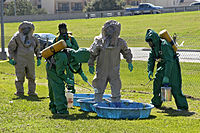
Photo from wikipedia
Environmental pollution is a critical issue that requires proper measures to maintain environmental health in a sustainable and effective manner. The growing persistence of several active pharmaceutical residues, such as… Click to show full abstract
Environmental pollution is a critical issue that requires proper measures to maintain environmental health in a sustainable and effective manner. The growing persistence of several active pharmaceutical residues, such as antibiotics like tetracycline, and anti-inflammatory drugs like diclofenac in water matrices is considered an issue of global concern. Numerous sewage/drain waste lines from the domestic and pharmaceutical sector contain an array of toxic compounds, so-called "emerging pollutants" and possess adverse effects on entire living ecosystem and damage its biodiversity. Therefore, effective solution and preventive measures are urgently required to sustainably mitigate and/or remediate pharmaceutically active emerging pollutants from environmental matrices. In this context, herein, the entry pathways of the pharmaceutical waste into the environment are presented, through the entire lifecycle of a pharmaceutical product. There is no detailed review available on carbon-dots (CDs) as robust materials with multifunctional features that support sustainable mitigation of emerging pollutants from water matrices. Thus, CDs-based photocatalysts are emerging as an efficient alternative for decontamination by pharmaceutical pollutants. The addition of CDs on photocatalytic systems has an important role in their performance, mainly because of their up-conversion property, transfer photoinduced electron capacities, and efficient separation of electrons and holes. In this review, we analyze the strategies followed by different researchers to optimize the photodegradation of various pharmaceutical pollutants. In this manner, the effect of different parameters such as pH, the dosage of photocatalyst, amount of carbon dots, and initial pollutant concentration, among others are discussed. Finally, current challenges are presented from a pollution prevention perspective and from CDs-based photocatalytic remediation perspective, with the aim to suggest possible research directions.
Journal Title: Journal of hazardous materials
Year Published: 2021
Link to full text (if available)
Share on Social Media: Sign Up to like & get
recommendations!